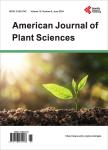Role of Plant Somatic Embryogenesis Receptor Kinases (SERKs) in Cell-to-Embryo Transitional Activity: Key at Novel Assorted Structural Subunits
Role of Plant Somatic Embryogenesis Receptor Kinases (SERKs) in Cell-to-Embryo Transitional Activity: Key at Novel Assorted Structural Subunits作者机构:School of Biotechnology Gautam Buddha University Greater Noida India
出 版 物:《American Journal of Plant Sciences》 (美国植物学期刊(英文))
年 卷 期:2014年第5卷第21期
页 面:3177-3193页
学科分类:1002[医学-临床医学] 100214[医学-肿瘤学] 10[医学]
主 题:Somatic Embryogenesis Cell-Signalling SERK Evolution
摘 要:Somatic Embryogenesis Receptor Kinase (SERK) family of receptor kinases is functionally diverse, involved in cell-to-embryo transition and controlling a number of other fundamental aspects of plant development. The morphological transformation of somatic to embryonic cells has drawn scientific attention utmost due to remarkable genetic-switch system evolved across species. Receptor kinases having direct role in somatic embryogenesis (SE) and involved in other functions are designated as “SERK and “SERK-like genes, respectively. We aim for phylogenetic reconstruction to reveal major SERK groups across plant species (angiosperm to gymnosperm) for their functional diversification. Data indicate that the development of SERK proteins occurred prior to the divergence of monocots and eudicots. Also, the SERK orthology is not directly proportional to their functions. Structure prediction results identified novel transmembrane topologies, short linear motifs and O-glycosylation sites exclusively in SERK proteins than SERK-like proteins. Comparative temporal expression analyses of SERK and SERK-like genes provided significant accordance with their physiological function. The identification of intrinsic disordered regions (IDRs) exclusively in SERK proteins was assumed to perceive external stress-induced signals that may lead to rapid protein folding. In a result it switches-on the precise cellular signals essential for the acquisition of SE. Moreover, the regulatory sequences of SERK genes are evolved with unique cellular fate deciding AP2-like ethylene responsive transcription factor AINTEGUMENTA binding sites for their spatial expression in SE. Based on these analyses we suggest future avenues of research that may be imperative for elucidating the importance of SERK gene evolution in SE.



